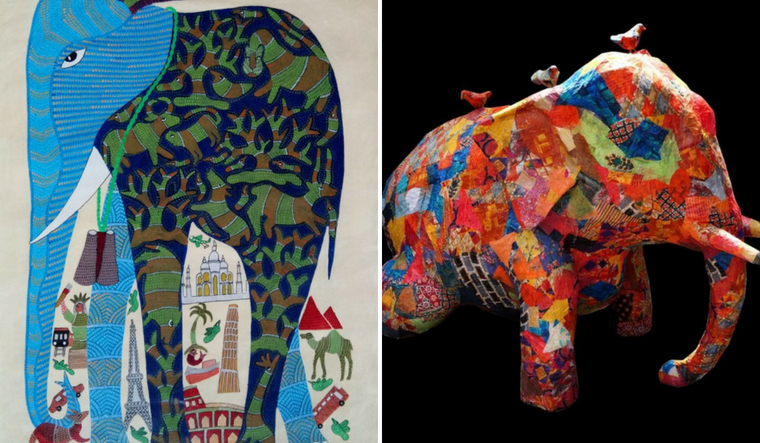In the Akbarnama (Book of Akbar), commissioned by the Mughal emperor in the 16th century to serve as the official account of his reign, there is a vibrant illustration of an action-packed elephant chase. The miniature painting, made circa 1590-95 in watercolour and gold on paper, depicts an incident in the life of Akbar which took place outside the fort of Agra in 1561. Akbar is mounted on his royal elephant Hawa’i, considered to be the toughest and the sturdiest of the lot. Hawa'i cannot be easily tamed, yet Akbar clambers up the giant tusker with ease and is shown chasing an equally fearsome elephant by the name of Ran Bagha.
Hawa'i chasing Bagha on a bridge of boats across the river Jamuna dominates this richly detailed but tumultuous composition where lesser mortals are jumping into the river from the collapsing bridge to escape the rampaging fury of the beasts. Even though the painting celebrates the majestic form of the elephant, human instinct to control and tame the noble animal is an uncomfortable strand in the hectic scene. Potters, masons, painters and sculptors may have shown the elephant in pastoral settings and enchanted forests through the ages, but the threat of chains and ropes coiling around its feet is always lurking somewhere in the shadows.
It is for this reason that an upcoming art exhibition in the capital will seek to reassess the representation of the elephant beyond its use in war and peace in royal households. It will address, in diverse mediums and styles, more pressing concerns of commercial and religious exploitation of the animal in temple rituals, political rallies, ostentatious weddings and circuses. Gaja Yatra: A Representation of Elephant Journeys Through Art will open at the Indira Gandhi Centre for the Arts on August 13, as part of the larger Gaj Mahotsav, a multidisciplinary festival in honour of the Asian Elephant. Held in in association with the Ministry of Environment, Forests and Climate Change, partnered by the International Fund For Animal Welfare and United Nations Environment and organised by the Wildlife Trust of India, the four-day-long elephant fest will see participation from policy makers, industry leaders, entertainment influencers, sports persons, public figures in arts and culture and eminent conservationists.
Ina Puri, the curator of Gaja Yatra, says how many artists approached to contribute for the exhibition were not comfortable making animal figures. But the ones that did eventually agree have come up with powerful narratives including themes around environmental issues, social and geographical uprooting and memory and loss. "Each artist reflected on the idea in their personal ways and the images will give you a sense of their trajectories. From Baiju Parthan's brilliant image to the Gond painters who layered their work with memories of folklore and poetry the range of work is extraordinary. Paresh Maity has created a stunning image of the 'mast' beast as if leaping out of its constraints, Jayasri Burman has made a sculpted elephant exquisitely bejewelled as has Rini Dhumal. Debasish Mukherjee has used textile and the Indian postage stamp image to tell a powerful story while Seema Kohli has drawn from the mythological to paint her canvas with fairytales remembered," says Puri.
She further adds, "Shuvaprasanna's elephant is a fierce raging beast while Sulu Mathew's elephant family is a playful, gentle portrait of a mother walking with the calves by her side. Venkat Shyam's magnificent elephant portrays the animal in all its primal glory, while Radhakrishnan creates a sculpture that is fluid and organic, the epitome of lightness as it stands poised in space."
Other participating artists in the exhibition include Jatin Das, Manu Parekh, Madhavi Parekh and Hemi Bawa, among others. Nature's great masterpiece will come alive in wondrous experiments with fibreglass, acrylic, metal, cloth and ink and for once will dominate the canvas for its own sake.



